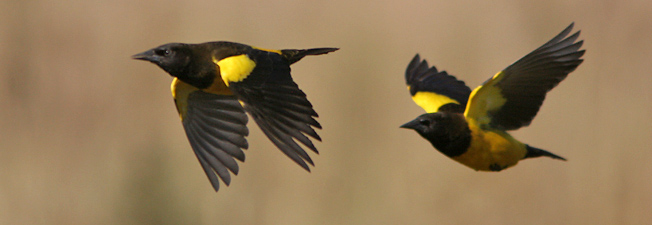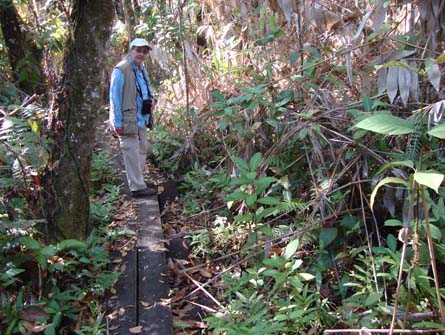| |
|
|
| |
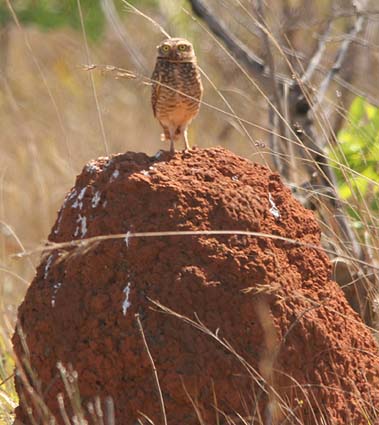 Emas National Park
provides a 1391 sq.km. (537 sq.mi.) preserve of rapidly declining
cerrado and grassland habitat in southern Brazil. The plateau has rich
red soil (right; termite mound with Burrowing Owl). Emas National Park
provides a 1391 sq.km. (537 sq.mi.) preserve of rapidly declining
cerrado and grassland habitat in southern Brazil. The plateau has rich
red soil (right; termite mound with Burrowing Owl).
The
park is located at the southwestern corner of the state of Goas,
adjacent to Mato Grosso and Mato Grosso du Sul. On a satellite image
(below left) it appears as unbroken habitat (light gray area)
surrounded entirely by extensive agriculture, primarily sugar cane and
corn fields. These fields attract grazers from the park — while the
name Parque Nacional dos Emas means "national park of the rheas," most
of the Greater Rheas we saw were in the bordering fields. At night
large mammals like Giant Anteater, Brazilian Tapir, and Maned Wolf also
forage in the adjacent fields [and we saw all of them at night].
There
are no overnight facilities in the park [indeed, they were starting to
cut down on access to night drives while we were there], so tourists
must stay in a hotel in Chapadao do Ceu. This is 25 km from the south
entrance gate of Emas (see map below right). To get to and from the
park one has to drive on one of the world's worst roads — a heavily
trafficked washboarded dirt road, passing dozens of loaded sugar cane
trucks enroute, and dealing with their dust (below).
|
|
| |
|
|
| |
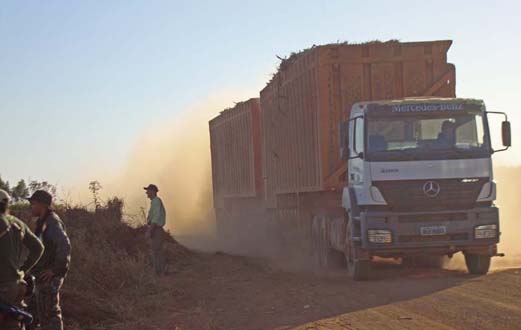 This
heavy truck traffic certainly made birding difficult around the edges
of the park (right) but in many cases the wildlife was lured to these
areas. Cultivated crops and stubble fields attracted birds and rodents,
which in turn attracted predators. Our only Maned Wolf was seen
pre-dawn hunting a stubble field south of the park. Our only Giant
Anteater was on a private ranch. This movement of wildlife out of the
park at night, and returning to the park at dawn, has caused concern
about mammalian road fatalities, and is affecting park populations. This
heavy truck traffic certainly made birding difficult around the edges
of the park (right) but in many cases the wildlife was lured to these
areas. Cultivated crops and stubble fields attracted birds and rodents,
which in turn attracted predators. Our only Maned Wolf was seen
pre-dawn hunting a stubble field south of the park. Our only Giant
Anteater was on a private ranch. This movement of wildlife out of the
park at night, and returning to the park at dawn, has caused concern
about mammalian road fatalities, and is affecting park populations.
The
park itself is lovely and quiet. Extensive golden grasslands stretch
toward the horizon (below left). Yet there are a surprising number of
forested areas, including gallery forest along the Formosa River, some
of which can be accessed on small boardwalks (below right). There is,
however, concern about park management and maintenance of these access
areas.
|
|
| |
|
|
| |
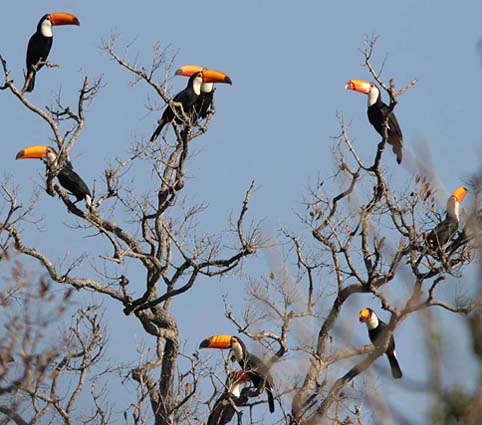 These
forested patches could be surprisingly birdy. We birded the gallery
forest on the Formosa River several days, and had something new every
time. It is the habitat of the endangered and much-wanted Cone-billed Tanager — see photos of the bird and its habitat on my Threatened species page. These
forested patches could be surprisingly birdy. We birded the gallery
forest on the Formosa River several days, and had something new every
time. It is the habitat of the endangered and much-wanted Cone-billed Tanager — see photos of the bird and its habitat on my Threatened species page.
We
visited a remote valley in the eastern part of the park that had dense,
tall chapada habitat. Among the unexpected there was a tree-full of Toco Toucans (right). Also located were White-eared Puffbird (below left) and Swallow-tailed Hummingbird (below right). The best bird in that forest was a young Crowned Eagle that soared right over our heard. It is also a very rare species, and is also highlighted on my Threatened species page.
When
visiting Emas NP, one is required to be accompanied by a local ranger.
Our local guide was Renato, and his help was invaluable in finding the
right dirt roads to reach some of these distant habitats. |
|
| |
|
|
| |
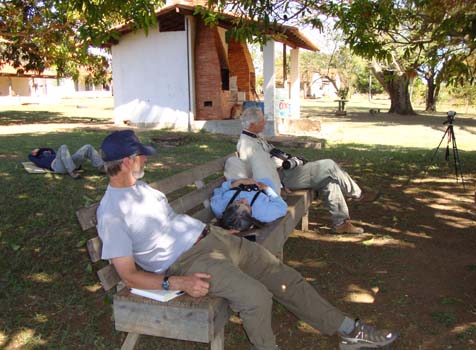 There was another nice patch of shade around Park Headquarters,
which was also on the Formosa River. We soon learned to stop here for a
mid-day break (left) and bring along a picnic lunch to save the
difficult ride back-and-forth to town for that meal. There was another nice patch of shade around Park Headquarters,
which was also on the Formosa River. We soon learned to stop here for a
mid-day break (left) and bring along a picnic lunch to save the
difficult ride back-and-forth to town for that meal.
Local
birds around headquarters have gotten used to tourists, so during our
mid-day snack we could be mobbed by Chopi Blackbirds or visited by a
Campo Flicker. Two species learned to eat right from our hands: Curl-crested Jay (below left) and a family group of Bare-faced Curassow (below right). |
|
| |
|
|
| |
|
|
| |
Specialties of the chapada and the grasslands, though, are the primary focus at Emas. We would occasionally see a Greater Rhea running down a park road (above), although most rheas seen were in stubble fields outside the park.
A highlight chapada species was Collared Crescentchest
(right). Crescentchests were traditionally included with the tapaculo
family but recent biochemical evidence has shown them to be a separate
lineage. They now form their own family, the Melanopareiidae. They are
secretive in thick chapada bushes, but do respond to tape. |
|
|
|
| |
|
A number of rare and exotic flycatchers inhabit the park's grasslands. Some, like Streamer-tailed Tyrant
(left), occur in pairs and often display to each other. Quite a number
of grassland tyrants are endangered and are featured on my Threatened species page, including Cock-tailed Tyrant and Sharp-tailed Grass-Tyrant.
Larger birds that caught our attention included a roost of Whistling Heron near headquarters (below left) and the fairly common Red-legged Sereima (below right).
|
|
|
| |
|
|
| |
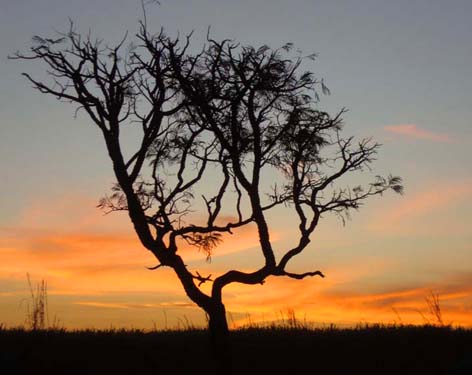 Because
mammals are out mostly at night, we often did a pre-dawn drive to the
park, and we usually did a night drive inside the park after dusk
(left). Marcelo operated a powerful spotlight powered by the van's
battery on these drives [see the Mammals pages for some of the successes]. Because
mammals are out mostly at night, we often did a pre-dawn drive to the
park, and we usually did a night drive inside the park after dusk
(left). Marcelo operated a powerful spotlight powered by the van's
battery on these drives [see the Mammals pages for some of the successes].
On
our next-to-last night we took a little-used side road, assured that it
would be fine, and drove the van straight into a Giant Armadillo
burrow! (below left). Giant Armadillo is the world's largest armadillo,
restricted in range, and capable of digging itself underground in
minutes. We never saw hide nor hair of the mythical beast itself, but
we saw several of their burrows. Now the front right tire was buried to
the axle in one. Marcelo tried to dig with a machete, but that was
hopeless. It looked like the American tourists might be spending the
night on a remote Emas road.
Fortunately Renato found
cell phone reception after a mile walk, and was able to organize help.
Braulio Carlos, another well-known Brazilian guide who was out
night-driving nearby, arrived with his jeep, and pulled us out with his
vehicle (below right). It was an adventure for sure. |
|
| |
|
|
| |
Emas
certainly has much to offer. It is out-of-the-way from the usual
Brazilian birding route, but it has many specialties and has its
outstanding mammals. Despite a number of difficulties in access, bad
roads, and distant lodging, I really enjoyed my visit there.
Yellow-rumped Marshbirds (right). |
|
|
|
| |
|
|
| |
EMAS trip list [25–29 July 2010]
BIRDS
Undulated Tinamou Crypturellus undulates: heard a couple of times along Formosa River
Small-billed Tinamou Crypturellus parvirostris: one seen on road, more heard
Red-winged Tinamou Rhynchotus rufescens: singles seen most days
Lesser Nothura Nothura minor: one at edge of road late one afternoon
Spotted Nothura Nothura maculosa: one seen south of park in rancher’s reserve at dusk; more heard there
Greater Rhea Rhea americana: 8-15 seen daily but more seen outside park than inside
Bare-faced Curassow Crax fasciolata: family group joined us for lunch daily at park headquarters
Brazilian Teal Amazonetta brasiliensis: a pair south of park in rancher’s marsh reserve
Whistling Heron Syrigma sibilatrix: one or two pairs seen daily near headquarters
Buff-necked Ibis Theristicus caudatus: 1-3 seen daily near headquarters
Turkey Vulture Cathartes aura: not common but someone saw 1-2 daily
Lesser Yellow-headed Vulture Cathartes burrovianus: common
Black Vulture Coragyps atratus: common
White-tailed Kite Elanus leucurus: 1-3 most days over grasslands
Long-winged Harrier Circus buffoni: 2-3 most days over grasslands
Savanna Hawk Buteogallus meridionalis: common but more outside of park than in
White-tailed Hawk Buteo albicaudatus: 2-4 daily, often at edge of park
Crowned Eagle Stephanoaetus coronatus:
three seen in flight in thickest cerrado in east-central Emas; perched
imm seen there later which took off and circled right over us — very
much a major bird highlight of the trip [see Threatened Birds page]
Southern Caracara Caracara plancus: very common
Yellow-headed Caracara Milvago chimachima: a few daily
Laughing Falcon Herpetotheres cachinnans: 1-2 most days in grasslands
American Kestrel Falco sparverius: scattered birds in grasslands
Aplomado Falcon Falco femoralis: fairly common most days, often near edge of park
Red-legged Seriema Cariama cristata: pairs seen daily, both inside and outside of park
Gray-necked Wood Rail Aramides cajanea: one at rancher’s reserve marsh
Southern Lapwing Vanellus chilensis: widespread
Picazuro Pigeon Patagioenas picazuro: common & widespread
Pale-vented Pigeon Patagioenas cayennensis: common daily along rivers
Eared Dove Zenaida auriculata: fairly common & widespread
Ruddy Ground Dove Columbina talpacoti: a few most days, often outside of park
Blue-and-yellow Macaw Ara ararauna: up to 40 every day, both inside and outside of park
Red-shouldered Macaw Diopsittaca nobilis: a large flock (60) on one day
Peach-fronted Parakeet Aratinga aurea: common daily
Yellow-faced Parrot Alipiopsitta xanthops: 6-10 most days, often at edge of park [see Threatened Birds page]
Blue-fronted Amazon Amazona aestiva: fairly common & widespread
Guira Cuckoo Guira guira: small numbers daily
Barn Owl Tyto alba: a few during night drives
Burrowing Owl Athene cunicularia: common in grasslands
Short-eared Owl Asio flammeus: one at park edge during dusk drive
Nacunda Nighthawk Podager nacunda: one over town square in Chapado do Ceu
Pauraque Nyctidromus albicollis: one during night drive
White-winged Nightjar Eleothreptus candicans: one male flew across road during night drive at edge of park; a female that same night might have been this species
Sick's Swift Chaetura meridionalis: small flock over rancher’s reserve on one day
Fork-tailed Palm Swift Tachornis squamata: a few around palms on Formosa River
Planalto Hermit Phaethornis pretrei: a few at forest edge on Formosa River
Swallow-tailed Hummingbird Eupetomena macroura: a few in thick cerrado
White-vented Violetear Colibri serrirostris: a few in thick cerrado
Glittering-bellied Emerald Chlorostilbon aureoventris: a few scattered females, one male
Horned Sungem Heliactin bilophus: one female or young male in thick cerrado; Singer had a male on another day
Amazon Kingfisher Chloroceryle amazona: one along Formosa River
Rufous-tailed Jacamar Galbula ruficauda: a few in riparian forest areas
White-eared Puffbird Nystalus chacuru: a pair called in for great views in thick cerrado
Toco Toucan Ramphastos toco: several daily; a dozen perched in one tree in cerrado
White-wedged Piculet Picumnus albosquamatus: singles most days in cerrado
White Woodpecker Melanerpes candidus: patchy groups of 4-12, usually in flight
Campo Flicker Colaptes campestris: found daily in small numbers
Lineated Woodpecker Dryocopus lineatus: one or two in forested areas
Rufous Hornero Furnarius rufus: daily around headquarters
Olivaceous Woodcreeper Sittasomus griseicapillus: a few in forested areas
Planalto Woodcreeper Dendrocolaptes platyrostris: two in riparian forest on Formosa River
Narrow-billed Woodcreeper Lepidocolaptes angustirostris: singles most days
Barred Antshrike Thamnophilus doliatus: a few heard most days in thicker scrub
Large-billed Antwren Herpsilochmus longirostris: pairs seen or heard on most days
Rusty-backed Antwren Formicivora rufa: patchy; up to 6 along river one day
Collared Crescentchest Melanopareia torquata: 1-4 each day in open scrub; these crescentchests were much wanted as they are now classified in their own family
Forest Elaenia Myiopagis gaimardii: one inside thick cerrado forest
Yellow-bellied Elaenia Elaenia flavogaster: a few most days at forest edge
Plain-crested Elaenia Elaenia cristata: singles on two days; good comparison to previous species
Southern Beardless Tyrannulet Camptostoma obsoletum: heard several times in scrub
Suiriri Flycatcher Suiriri suiriri: pair in open cerrado gave displays
Chapada Flycatcher Suiriri islerorum: two pairs in open cerrado undertook full displays [see Threatened Birds page]
Sooty Tyrannulet Serpophaga nigricans: single bird on two days at ‘capybara grotto’
Bran-colored Flycatcher Myiophobus fasciatus: one in mixed flock on forest edge along Formosa River
Sharp-tailed Grass Tyrant Culicivora caudacuta: small colonies encountered several times in open grasslands [see photo on Threatened Birds page]
Common Tody-Flycatcher Todirostrum cinereum: just a couple recorded
Vermilion Flycatcher Pyrocephalus rubinus: several daily around headquarters
Yellow-browed Tyrant Satrapa icterophrys: one in pig wallow grasslands
Gray Monjita Xolmis cinereus: singles most days, not common
White-rumped Monjita Xolmis velatus: widespread & common in grasslands
Streamer-tailed Tyrant Gubernetes yetapa: several pairs most days, some displaying
Cock-tailed Tyrant Alectrurus tricolor: males on territory in grasslands, up to 15/day
Cattle Tyrant Machetornis rixosa: one most days at headquarters
Great Kiskadee Pitangus sulphuratus: seen or heard most days along rivers
Fork-tailed Flycatcher Tyrannus savanna: one austral migrant encountered in open grassland
Rufous Casiornis Casiornis rufus: singles most days
Short-crested Flycatcher Myiarchus ferox: a few in forested areas
Brown-crested Flycatcher Myiarchus tyrannulus: one along river at rancher’s reserve
Helmeted Manakin Antilophia galeata:
calling males daily in riverine forest edging Formosa River; some
called in for photos, sometimes only females responded to tape
Rufous-browed Peppershrike Cyclarhis gujanensis: one heard in riverine forest
Curl-crested Jay Cyanocorax cristatellus: about a dozen daily joined us for lunch at headquarters
White-rumped Swallow Tachycineta leucorrhoa: could be locally common over rivers
Gray-breasted Martin Progne chalybea: a few only
Southern Rough-winged Swallow Stelgidopteryx ruficollis: 5-15 most days in park
(Southern) House Wren Troglodytes [a.] musculus: one daily at headquarters
Masked Gnatcatcher Polioptila dumicola: a few in mixed flocks at forest edge or in cerrado
Chalk-browed Mockingbird Mimus saturninus: common & widespread
Pale-breasted Thrush Turdus leucomelas: two along Formosa River one day
Yellowish Pipit Anthus lutescens: common in grazed land outside park
Tropical Parula Parula pitiayumi: a few in mixed flocks in riverine forests
Masked Yellowthroat Geothlypis aequinoctialis: one male, one female in marshes seen well
White-striped Warbler Basileuterus leucophrys: a pair inside riverine forest on Formosa River were responsive to tape
White-banded Tanager Neothraupis fasciata: these tanagers that recall Loggerhead Shrikes were patchy in open cerrado grasslands [photo on Threatened Birds page]
Cone-billed Tanager Conothraupis mesoleuca:
a singing male seen or heard every day in riverine forest on Formosa
River at a known spot; it is considered a “Critically Endangered”
species although it is probably more common than usually indicated.
Photos and more discussion on the Threatened Birds page.
White-rumped Tanager Cypsnagra hirundinacea: patchy in open cerrado grasslands
Palm Tanager Thraupis palmarum: a dozen daily in riverine forest, often around palms
Burnished-buff Tanager Tangara cayana: regular in riverine forest at headquarters [photo on Tanagers page]
Blue Dacnis Dacnis cayana: a few in mixed forest edge flocks
Rufous-collared Sparrow Zonotrichia capensis: locally common
Grassland Sparrow Ammodramus humeralis: very widespread & common in grasslands
Saffron Finch Sicalis flaveola: locally common in weedy areas
Wedge-tailed Grass-Finch Emberizoides herbicola: widespread in grasslands
Lesser Grass-Finch Emberizoides ypiranganus: several in marsh/grassland edges
Blue-black Grassquit Volatinia jacarina: patchy in grasslands
Plumbeous Seedeater Sporophila plumbea: common & widespread
Rusty-collared Seedeater Sporophila collaris: only a few here or there
Double-collared Seedeater Sporophila caerulescens: a pair at rancher’s reserve, south of park
Black-masked Finch Coryphaspiza melanotis: one in open cerrado grassland posed for photos [see Threatened Birds page]
Black-throated Saltator Saltator atricollis: found daily throughout park
Chopi Blackbird Gnorimopsar chopi: a flock of 50 or so was at headquarters daily
Yellow-rumped Marshbird Pseudoleistes guirahuro: small flocks of ~8 birds encountered various times
Purple-throated Euphonia Euphonia chlorotica: a few most days at forest edge
House Sparrow Passer domesticus: common in Chapada do Ceu; not inside Emas
Heard only by guide (or, as to rails, heard by us but would have been a lifer, so not counted): Roadside Hawk Buteo magnirostris, Uniform Crake Amaurolimnas concolor, Ash-throated Crake Porzana albicollis, Blackish Rail Pardirallus nigricans, Violet-capped Woodnymph Thalurania glaucopis, Green-barred Woodpecker Colaptes melanochloros, Pale-breasted Spinetail Synallaxis albescens, Rusty-backed Spinetail Cranioleuca vulpina, and Euler's Flycatcher Lathrotriccus euleri.
MAMMALS
Giant Anteater Myrmecophaga tridactyla: one just south of park in private reserve on several days
Six-banded Armadillo Euphractus sexcinctus: one in the pre-dawn at edge of park
Crab-eating Fox Cerdocyon thous: nightly inside the park on every night drive
Maned Wolf Chrysocyon brachyurus: one outside the park pre-dawn in stubble field
Hoary Fox Pseudalopex vetulus: one inside the park during a night drive
Brazilian Tapir Tapirus terrestris: two outside the park pre-dawn in stubble field
White-lipped Peccary Tayassu pecari: large pack of all ages in muddy marsh one afternoon
Pampas Deer Ozotoceros bezoarticus: fairly common during daylight drives inside park
Striped Hog-nosed Skunk Conepatus semistriatus: a couple seen after dark
Photos of most of these mammals appear on my two-page Mammals set.
In addition, we plowed into a recent burrow made by Giant Armadillo Priodontes maximus, and were stuck for several hours at dusk. During the day we found recent foot-prints of Puma Puma concolor and of Jaguar Panthera onca.
I am still sorting out photos of lizards and odes. |
|
|
| |
|
|
| |
|
page created 4-6 Sep 2010
|
|
© Don Roberson 2010 |
|
|

 Emas National Park
provides a 1391 sq.km. (537 sq.mi.) preserve of rapidly declining
cerrado and grassland habitat in southern Brazil. The plateau has rich
red soil (right; termite mound with Burrowing Owl).
Emas National Park
provides a 1391 sq.km. (537 sq.mi.) preserve of rapidly declining
cerrado and grassland habitat in southern Brazil. The plateau has rich
red soil (right; termite mound with Burrowing Owl). 
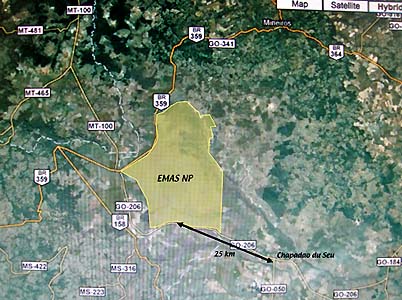
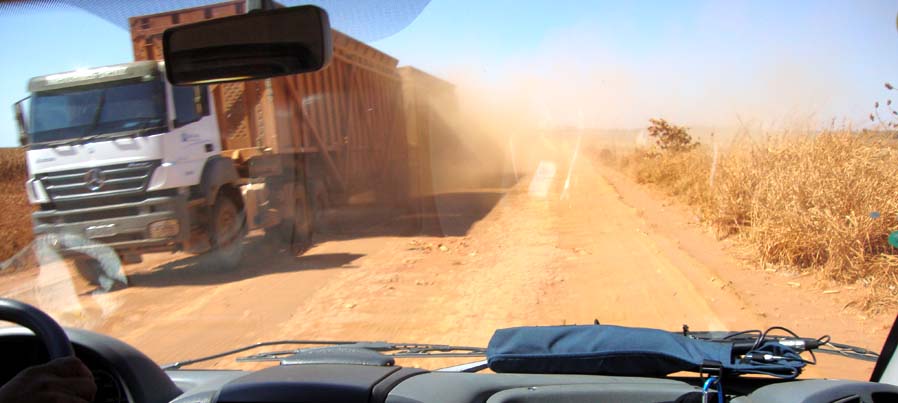
 This
heavy truck traffic certainly made birding difficult around the edges
of the park (right) but in many cases the wildlife was lured to these
areas. Cultivated crops and stubble fields attracted birds and rodents,
which in turn attracted predators. Our only Maned Wolf was seen
pre-dawn hunting a stubble field south of the park. Our only Giant
Anteater was on a private ranch. This movement of wildlife out of the
park at night, and returning to the park at dawn, has caused concern
about mammalian road fatalities, and is affecting park populations.
This
heavy truck traffic certainly made birding difficult around the edges
of the park (right) but in many cases the wildlife was lured to these
areas. Cultivated crops and stubble fields attracted birds and rodents,
which in turn attracted predators. Our only Maned Wolf was seen
pre-dawn hunting a stubble field south of the park. Our only Giant
Anteater was on a private ranch. This movement of wildlife out of the
park at night, and returning to the park at dawn, has caused concern
about mammalian road fatalities, and is affecting park populations.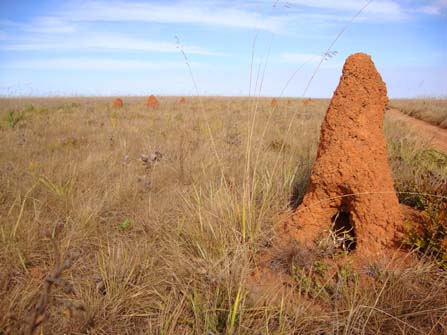
 These
forested patches could be surprisingly birdy. We birded the gallery
forest on the Formosa River several days, and had something new every
time. It is the habitat of the endangered and much-wanted Cone-billed Tanager — see photos of the bird and its habitat on my Threatened species page.
These
forested patches could be surprisingly birdy. We birded the gallery
forest on the Formosa River several days, and had something new every
time. It is the habitat of the endangered and much-wanted Cone-billed Tanager — see photos of the bird and its habitat on my Threatened species page. 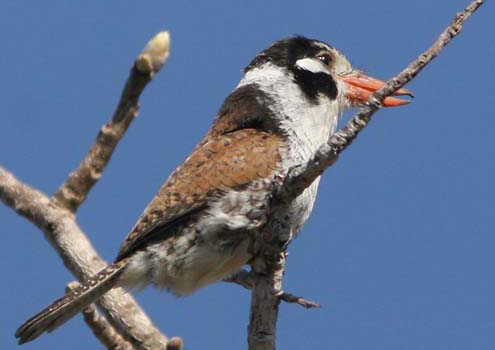
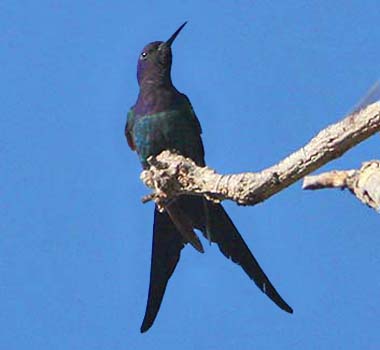
 There was another nice patch of shade around Park Headquarters,
which was also on the Formosa River. We soon learned to stop here for a
mid-day break (left) and bring along a picnic lunch to save the
difficult ride back-and-forth to town for that meal.
There was another nice patch of shade around Park Headquarters,
which was also on the Formosa River. We soon learned to stop here for a
mid-day break (left) and bring along a picnic lunch to save the
difficult ride back-and-forth to town for that meal. 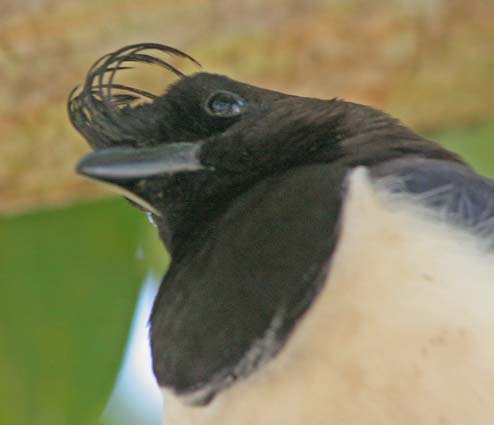
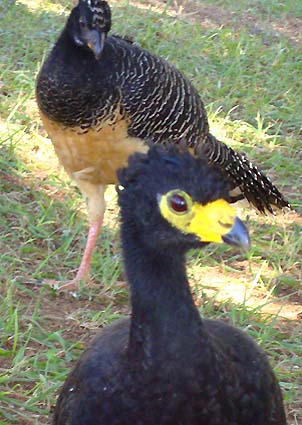
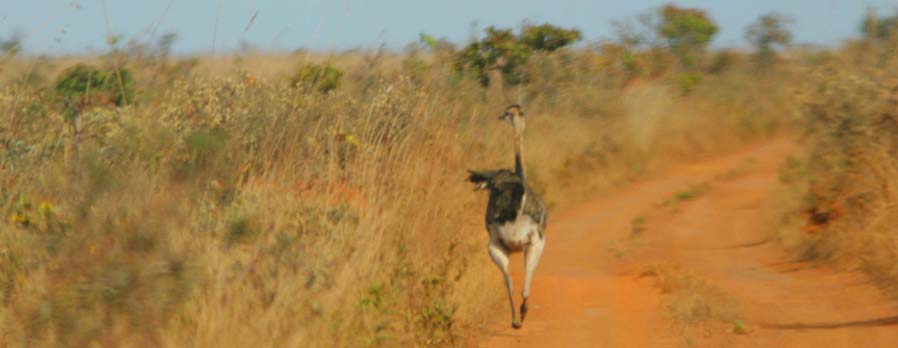
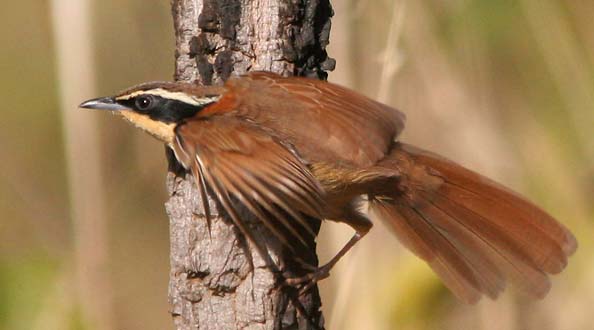

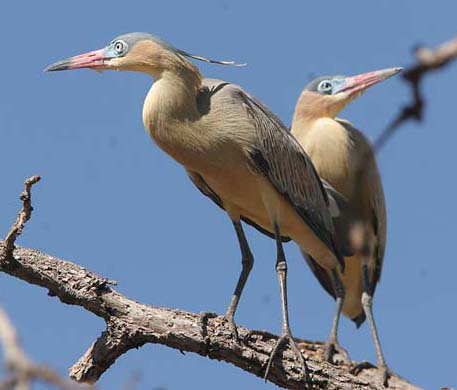
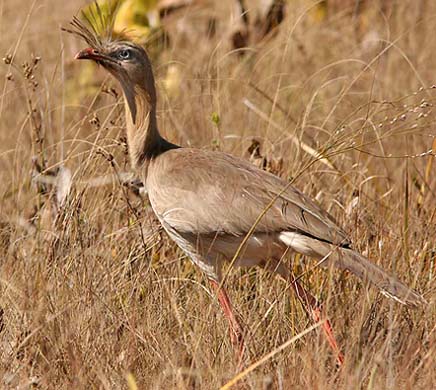
 Because
mammals are out mostly at night, we often did a pre-dawn drive to the
park, and we usually did a night drive inside the park after dusk
(left). Marcelo operated a powerful spotlight powered by the van's
battery on these drives [see the Mammals pages for some of the successes].
Because
mammals are out mostly at night, we often did a pre-dawn drive to the
park, and we usually did a night drive inside the park after dusk
(left). Marcelo operated a powerful spotlight powered by the van's
battery on these drives [see the Mammals pages for some of the successes]. 

